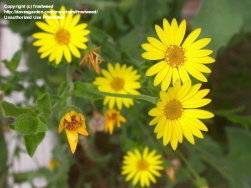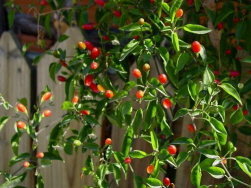





Texas is an interesting state filled with beautiful plants. Ten of these plants are listed here but there are thousands more in the hills and valleys of Texas just waiting to be rediscovered.
Texas is a large state historically filled with larger than life characters. The Texans I have had the pleasure of knowing in my lifetime have all had an endearing, never-say-quit spirit. In an environment of unrelenting heat and drought of historical proportions in much of the state, Texans have not only survived but have thrived. The same is true of the native plants found in the state.
Wild herbs which were once prized for their nutritional or medicinal properties have been forgotten and left to the wild and the ravages of nature. Many of these wild herbs are beautiful and would make lovely additions to the home flower garden. While many more are not so aesthetically pleasing but do have an interesting history. Simply surviving the harsh Southwestern climate for centuries is a story in itself.
American Licorice (Glycyrrhiza lepidota) is a perennial member of the pea family which can grow to 3 feet tall. G. lepidota white to cream colored blooms are closely set and crowded on a spiked stem. Blooms open in June and July. Stems have sticky hairs which may irritate skin of some people. Grows best in a shaded or partially shaded area where soil is kept moist such as near streambeds. Can be found growing in a variety of soils and even tolerates heavy clay. Rhizomes and leaves have been used by herbalists throughout history to treat a myriad of ailments. The licorice flavor rhizomes impart to the tea makes the ‘medicine' easier to swallow. G. lepidota is a host plant to the silver-spotted skipper butterfly (Epargyreus clarus)

Clasping St. Johnswort (Hypericum gymnanthum) is a perennial which can be found growing in part to full sun in loamy, wetland areas. It is a pretty perennial to add to the bog garden or along the edge of a creek bed in a wooded area. Small yellow blooms appear from summer well into autumn. Foliage is pale green and looks great when planted in groupings including darker green foliage.
Desert Savior (Echeveria strictiflora) is a perennial succulent-leafed herb with lovely red flowers on racemes from June well into autumn. E. strictiflora is an evergreen which reaches approximately one foot tall with a spreading habit. Although it will grow in full sun, it thrives when grown in lightly shaded areas. Drought tolerant, E. strictiflora will thrive in sandy, gravelly soils such as those often found in rock gardens.
Nodding Onion (Allium cernuum) is a perennial member of the lily family which can be found along streambeds, in prairies and in wet hilly areas. A. cernuum has a central leafless stalk that rises to just under 2 feet tall with clusters of white, lavender or pink blooms in July and August which have a nodding habit. A. cernuum does best in moist dark loam soil mixed with gravelly-sandy material and full sun to partial shade. It does not like extreme heat or dry summers. *Considered a noxious weed in Arkansas.
Rattlesnake Flower (Brazoria truncata) is an annual and a member of the mint family. B. truncata is found across south Texas. Plant thrives in white sandy areas such as the Sand Sheet in Southern Texas. Early spring blooms of pink to purple open on racemes. Unusual square shaped stems never reach taller than one foot. Plants are sub-shrubs which have a purple cast in the heat of summer.
Star Grass (Aletris aurea) is a nice addition to any bog garden. Aletris aurea is most often found growing in wetlands although it may sometimes be found in dry pine-woods. Historically used as a remedy for various stomach ailments but evidence to support its use is elusive and in fact, it may be dangerous if any part of the plant, or derivatives from it, are taken internally. Yellow-orange flowers bloom from April to July. Leaves are long and narrow reaching 8 inches on some plants. Plant itself may grow to 3 feet tall. A member of the Lily family of plants, A. aurea will thrive in any loamy garden soil.

White Snakeroot (Ageratina altissima) can be found from the Dakota's down to Texas, east to Florida and up the east coast to Canada. A. altissima grows in shady forested areas. This wild native herb was believed to be a treatment for snakebites by early settlers hence its common name, snakeroot. Do not use as medicine as rhizomes and other parts of this plant are toxic. Plants can reach 3 feet high. Fuzzy white blooms appear in clusters from July through October. Being a member of the Aster family of plants, A. altissima will grow in any garden soil suitable to this species of plant.
Yellow Flowered Onion (Allium coryi) is thought to be found only in western Texas. It grows along rocky slopes and across the plains in dry, sandy soil. It also grows in loamy clay soil. A. coryi prefers to grow in partially shaded areas. Four inch globular shaped yellow blooms tinted with red on the edges appear from March through May. Plant grows to 12 inches tall.
I have grown or have seen these plants growing wild here in North Florida Ageratina altissima, Capsicum annuum and Heterotheca subaxillaris.
*Please note that nothing contained in this article should be construed as suggesting the use of any plant for medicinal purposes or even as an edible plant.
Photo at top right is Nodding Onion (Allium cernuum) courtesy of Dave's Garden member Todd Boland.
Sources:
Flora of North America
Lady Bird Johnson Wildflower Center
U.S.D.A. Plants Database
Dave's Garden Plant Files
"Wildflowers of Texas" by G. Ajilvsgi
ISBN: 0940672731
"Herbs: An Illustrated Encyclopedia" by Kathi Keville
ISBN: 1567990657
(Editor's Note: This article was originally published on February 28, 2009. Your comments are welcome, but please be aware that authors of previously published articles may not be able to respond to your questions.)
Copyright © www.100flowers.win Botanic Garden All Rights Reserved